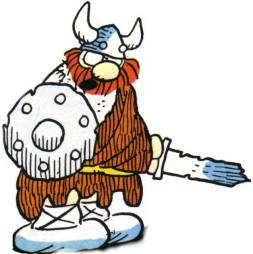| Source: picstopin.com |
Did Vikings really wear horned helmets?
Forget almost every Viking costume you’ve ever seen. Yes, the
pugnacious Scandinavians probably sported headgear when they marched
into battle, but there’s no reason to believe it was festooned with
horns. In depictions dating from the Viking age—between the eighth and
11th centuries—warriors appear either bareheaded or clad in simple
helmets likely made of either iron or leather. And despite years of
searching, archaeologists have yet to uncover a Viking-era helmet
embellished with horns. In fact, only one complete helmet that can
definitively be called “Viking” has turned up. Discovered in 1943 on
Gjermundbu farm in Norway, the 10th-century artifact has a rounded iron
cap, a guard around the eyes and nose, and no horns to speak of.
The popular image of the strapping Viking in a horned helmet dates back to the 1800s, when Scandinavian artists like Sweden’s Gustav Malmström included the headgear in their portrayals of the raiders. When Wagner staged his “Der Ring des Nibelungen” opera cycle in the 1870s, costume designer Carl Emil Doepler created horned helmets for the Viking characters, and an enduring stereotype was born.
Malmström, Doepler and others may have been inspired by 19th-century discoveries of ancient horned helmets that later turned out to predate the Vikings. They may also have taken a cue from ancient Greek and Roman chroniclers, who described northern Europeans wearing helmets adorned with all manner of ornaments, including horns, wings and antlers. But not only did this headgear fall out of fashion at least a century before the Vikings appeared, it was likely only donned for ceremonial purposes by Norse and Germanic priests. After all, horns’ practicality in actual combat is dubious at best. Sure, they could help intimidate enemies and maybe even poke out a few eyes, but they would have been even more likely to get entangled in a tree branch or embedded in a shield.
The popular image of the strapping Viking in a horned helmet dates back to the 1800s, when Scandinavian artists like Sweden’s Gustav Malmström included the headgear in their portrayals of the raiders. When Wagner staged his “Der Ring des Nibelungen” opera cycle in the 1870s, costume designer Carl Emil Doepler created horned helmets for the Viking characters, and an enduring stereotype was born.
Malmström, Doepler and others may have been inspired by 19th-century discoveries of ancient horned helmets that later turned out to predate the Vikings. They may also have taken a cue from ancient Greek and Roman chroniclers, who described northern Europeans wearing helmets adorned with all manner of ornaments, including horns, wings and antlers. But not only did this headgear fall out of fashion at least a century before the Vikings appeared, it was likely only donned for ceremonial purposes by Norse and Germanic priests. After all, horns’ practicality in actual combat is dubious at best. Sure, they could help intimidate enemies and maybe even poke out a few eyes, but they would have been even more likely to get entangled in a tree branch or embedded in a shield.

Poor Hagar!
The ONLY possible purpose would be to deflect a sword blow that might otherwise have caught a shoulder. BUT, such a blow would probably knock off the helmet, leaving the wearer unprotected form the next one.
ReplyDeleteYou're probably right, Gorges. They may have worn something on their helmets to make them look taller and fiercer, but horns are really too heavy.
DeleteHello Chicken Feathers
ReplyDeleteMe and you are on the same page. My name is Sam and I run The Last Tradition. Check out my site and if you like what you see add me to you Blog roll. We belong together. Hope to hear from you.
http://www.thelasttradition.com/
Thank you for stopping by and commenting Samuel! I try to keep politics out of the blog although it's very hard to do sometimes. I took a look-see at yours - and yes, we do agree and I read a lot of them you have listed! I don't have a blog roll, but don't let that stop you from visiting! :o)
Delete